Spread over an area of about 29 sq. km. (28.73 sq. km. as per the government notification), Keoladeo National Park is situated on the extreme western edge of the Gangetic basin, where the Rivers Gambhir and Banganga, tributaries of the Yamuna, once converged, in the Bharatpur district of Rajasthan, India. It was notified as a national park on August 27, 1981, by the Govt. of Rajasthan vide notification No. RJ.2539 RAJASTHAN GAZETTE Extraordinary dated the 27th August 1981.
The park, named after the Keoladeo temple situated within its boundaries, is also called Keoladeo Ghana National Park. The wetland reserve locally known as “Ghana,” meaning “dense” in the local language, is also called ‘Keola Dev’ after a temple deity of the same name. It is the most famous Indian bird sanctuary. Earlier, it was designated and popularly known as the Bharatpur Bird Sanctuary, and it was given the legal status of a bird sanctuary in 1973.
Keoladeo National Park comprises a mixture of various habitats, including wetlands and grasslands, hosting more than 375 plant species with rich fauna. More than 350 species of birds are found in this park, 27 mammals, 13 reptiles, 7 amphibians, 58 fish species, and more than 100 species of insects and spiders. It is often called a ‘Bird’s Paradise’.
Key Facts about Keoladeo National Park
- Historical Use: Previously the private duck shooting preserve of the Maharaja of Bharatpur since the 1850s.
- Biodiversity Hotspot: Home to over 370 bird species, including the endangered Siberian Crane.
- International Importance: Recognized as one of the Wetlands of International Importance under the Ramsar Convention (1971).
- Man-Made Wetland: Created by Maharaja Suraj Mal in the 18th century.
- Tourist Attraction: Popular from November to March during the migratory season.
- Research and Education: Vital for ecological and environmental studies.
- Ramsar Site number 230.
- UNESCO World Heritage Site (1985): Designated for its outstanding universal value.
- Cultural Heritage: Includes ancient temples like the Keoladeo Temple.
The Keoladeo National Park is located about 185 km from Delhi, along the Delhi-Jaipur Highway, 55 km from Agra, and 2 km southeast of Bharatpur in the Bharatpur district of Rajasthan. The National Park encloses the famous Keoladeo Temple on the Jaipur-Agra highway.
The Park is zoned based on a block structure aimed at maintaining diverse habitat types. Accordingly, Keoladeo National Park is divided into four main management zones, viz.:
Zone – Area (Ha)
1. Wetland Zone – 835 (29.10%)
2. Grassland Zone – 835 (29.10%)
3. Woodland Zone – 1062 (37.33%)
4. Tourism Zone – 47 (01.5 %)
Total – 28.73 sq. km.
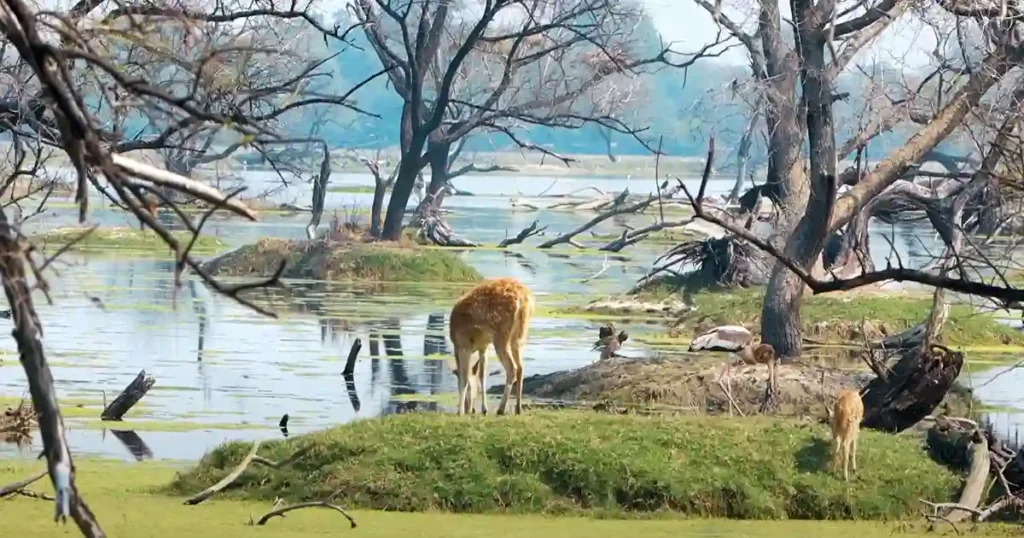
Keoladeo National Park Map
Keoladeo National Park and the Keoladeo ESZ are under the jurisdiction of Bharatpur district and Bharatpur Tehsil in Rajasthan. Bharatpur is bordered by Dausa district to the west, Haryana to the north, Agra (Uttar Pradesh) to the east, and Dholpur district to the south.
The maps and revenue maps available with government authorities guided the surveys and ground truthing conducted for the preparation of the Zonal Management Plan (ZMP) for the Keoladeo ESZ. The Deputy Conservator of Forests (DCF), Wildlife, Bharatpur, has prepared geo-referenced maps, including an updated base map. This map reflects existing land use and analyzes trends, potentials, and issues related to conservation and biodiversity. It also includes projections on demography, land use, socio-economic conditions, and transportation needs.
The geographical coordinates of Keoladeo National Park are 27°07’06” N to 27°12’02” N latitude and 77°29’05” E to 77°33’09” E longitude. The map below shows the ESZ GPS points, ESZ boundary, core area, and protected area for informational purposes only.
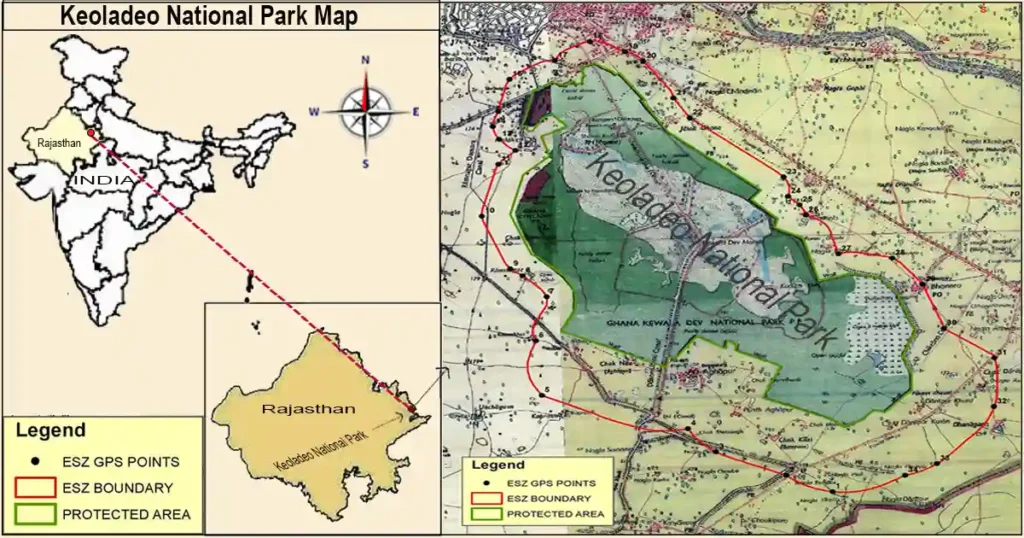
Keoladeo National Park Opening Time
Keoladeo National Park opens all days throughout the year from sunrise to sunset with varying hours depending on the season:
- Winter: The park is open from approximately 7:30 AM to 5:30 PM.
- Summer: The park is open from approximately 6:30 AM to 6:30 PM.
These times are approximate and may slightly vary depending on the exact timing of sunrise and sunset.
Keoladeo National Park Tickets Price
Keoladeo National Park ticket prices are posted at the gate for each category, including applicable taxes. Various trip options are available, such as hiring a bicycle, Tonga, or E-Rickshaw. Visitors can also explore the park by walking. A wildlife guide is compulsory when using an E-Rickshaw and not necessary for tourists going on a bicycle, walking, or by Tonga. No additional charges are required for binoculars with E-Rickshaw and Wildlife Guide. Drone shooting is strictly prohibited.
There are two canteens within a 5 km range inside the park, offering light refreshments. Cycling is the best mode of transport, as it gives you the freedom to explore almost anywhere and spend as much time as you wish photographing birds.
| Keoladeo National Park Ticket Prices (including tax): *Note: These prices are indicative and may vary. |
|
| Entry Fee | |
| Indian Visitors | ₹130+6=136 per person |
| Indian Students | ₹50+6=56 per person |
| Bicycle | |
| Ordinary Cycle | ₹100 Full Day |
| Ranger Cycle | ₹150 Full Day |
| Tonga | ₹12000 (Three hours) |
| E-Rickshaw (A wildlife guide is compulsory when using an E-Rickshaw) | |
| E-Rickshaw | ₹800+800=1600 (for two hours) |
| E-Rickshaw | ₹1200+1200=2400 (for three hours) beyond 3-hour trip₹300 per hour for E-Rickshaw & Wildlife Guide) |
| Boat | |
| Small Boat 4-seater | ₹300 for one hour |
| Big Boat 8-seater | ₹600 for one hour |
| Video Camera | |
| Video camera professional (Indian Agency) | ₹10560.00 |
| Video camera professional (Foreign Agency) | ₹16000.00 |
| Movie Camera | |
| Movie camera for feature film (Indian Agency) | ₹70400.00 |
| Movie camera for feature film (Foreign Agency) | ₹104000.00 (prior permission from CWLW, Jaipur is required) |
Best Time to Visit Keoladeo National Park
The best time to visit Keoladeo National Park is from October to March. During this time, it plays host to a great number of migratory birds; as many as more than 20,000 birds might nest in well-watered years. This was also the period for the critically endangered Siberian Crane, which used the park as its only known wintering site in the region.
Tourists will have the opportunity to view a large heronry of 15 species of herons, cormorants, spoonbills, ibises, and storks. The park is home to more than 375 species of birds, among them 140 species of waterfowl. It is a great time to visit the park and get good weather and maximum birdlife at this time of the year, thus making it perfect for a feel of the richest biodiversity.
Temperature & Rainfall Throughout the Year at Keoladeo National Park
| Month | Temperature (°F) | Temperature (°C) | Rainfall (mm) |
| January to March |
50°F – 80°F | 10°C – 27°C | 4 mm – 7 mm |
| April to June |
75°F – 105°F | 24°C – 45°C | 11 mm – 30 mm |
| July to September |
70°F – 95°F | 21°C – 35°C | 100 mm – 165 mm |
| October to December |
55°F – 85°F | 13°C – 30°C | 3 mm – 8 mm |
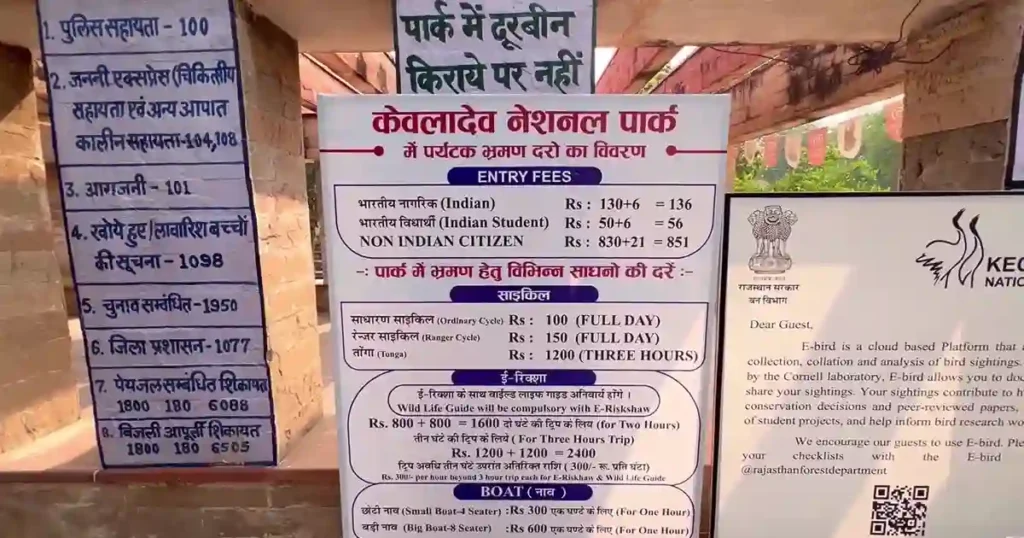
Keoladeo National Park Boundary
Keoladeo National Park has a range known as Keoladeo Ranges. The boundary of KNP consists of a core area of 28.73 sq. km, and the Eco-Sensitive Zone (ESZ) has a total area of 25.61 sq. km. Considering the richness of flora and fauna, heritage importance, tourist perspectives, and environmental importance, an area of 500 meters to 1.5 km around the boundary of Keoladeo National Park, Bharatpur district, Rajasthan, has been declared as ESZ, with a total coverage of 25.61 sq. km by MoEF&CC (Ministry of Environment, Forest and Climate Change) dated 27th July 2019.
1. Core Area Boundary:
The core area boundaries (28.73 sq. km) of the Keoladeo National Park are described as follows:
- Northern Boundary: Forest area near Bharatpur, extending from village Shri Nagar to the northern boundary of village Bharatpur Kasba Chak-1.
- Eastern Boundary: Forest line adjoining the revenue areas of village Bharatpur, Jatoli Ghana, Barso, Bahanera, Jaipur-Agra Road, and adjacent revenue areas.
- Southern Boundary: Adjoining the forest boundary at Chak Bahanera and Chak Darapur.
- Western Boundary: Revenue areas of village Chak Shyorawali, Ramnagar, and Malah.
2. Eco-Sensitive Zone Boundary:
The boundaries of the Eco-Sensitive Zone (ESZ 25.61 sq. km.) around Keoladeo National Park are described as follows:
- Northern Boundary: The extent of the ESZ is marked on the boundary of the Protected Forest block Ghana Keoladeo and includes the villages of Srinagar and Bhagalpur City, with a buffer zone ranging from 0.5 meters up to 1.5 km. This Northern boundary of the ESZ is co-terminus with the boundary of the Protected Forest block Ghana Keoladeo and includes the entire Protected Forest within the ESZ.
- Eastern Boundary: The perimeter of the ESZ starts and extends along National Highway No. 11 (now NH-21), maintaining a distance of 500 meters from the National Park boundary.
- Southern Boundary: The ESZ boundary is co-terminus with the boundary of the National Park along National Highway No. 123 from Bharatpur to Dhaulpur, extending 1.5 km from the National Park boundary.
- Western Boundary: In the west direction, the boundary is co-terminus with the boundary of the National Park, with a buffer zone ranging from 0.5 to 1.5 km, including the areas of Chak Sheorawali, Aghapur, Ramnagar Chak Ramnagar, and Mallah.
Here is the information on the ESZ boundary in a table format:
| Direction | Extent (km) |
| North |
0.5 |
| North-East | 0.5 |
| East | 0.5 |
| South-East | 1.5 |
| South | 1.5 |
| South-West | 1.5 |
| West | 0.5 |
| North-West | 0.5 |
Villages under ESZ Keoladeo National Park
Keoladeo Eco-Sensitive Zone (ESZ) includes 22 villages, as per the Gazette Notification of MoEF&CC dated 27th July 2019. Of these, 2 villages fall within Keoladeo National Park: Jawahar Nagar Colony and Bharatpur Kasba Chak-1.
The remaining 20 villages are in the broader ESZ area outside the core park. These ESZ villages are Jatoli, Chaksiyosingh, Nagla Banjara, Ghasola, Khohri Nagla, Chakkazi, Khokhar, Behnera, Darapur Khurd, Darapur Kalan, Naglaphatiyar, Dhanagarh, Naswaria, Chak Sheorawali, Chak Choba, Sakatpur, Chak Darapur, Aghapur, Ramnagar, Chak Ramnagar, and Mallah.
Historical Highlights of Keoladeo National Park
The historical highlights of the park date back to the 1700s and were built to retain water. Although historical records are few, it may be assumed that sentiment was behind the protection given to birds and mammals of the Keoladeo Ghana National Park. Later the same birds and mammals were carefully looked after so that they might provide the Rajah (King) and his guests with sport.
Old shooting records of this area are inscribed on stone plaques from 1002 to 1973 inside the sanctuary. These records reveal that the number of guns used for a single day’s shoot ranged from 11 to 79 and the number of bagged birds ranged from 76 to 4273 ducks. This further points to the enormous concentration of birds even 51 years ago. Despite the heavy shooting pressure birds have always flocked to Ghana.
The hunters included kings, British viceroys, princes, and local elites, who used the dykes to shoot birds during winter. The park’s design, with dykes, trees, and water gates, reflects meticulous planning and management.
Historical Highlights-
- 1726-1763: Ajan Bund on the river Gambhir was constructed by Maharaja Suraj Mal (1707–1763), the then ruler of Bharatpur, known for his military skills and efforts to improve infrastructure, including water management systems.
- 1850 – 1899: Inspired by the duck shoot reserves in England, Prince Harbhanji of Morvi, Gujarat, had bandhs and dykes constructed, increasing the water-holding capacity of the depression.
- 1899: Prince Harbhanji of Morvi, Gujarat, was appointed administrator of Bharatpur State. He developed the depression area into a duck shooting reserve by constructing bandhs and dykes to increase water holding.
- 1901: The Reserve flooded for the first time, leading to the creation of a regular water distribution system. This flooding caused an increase in aquatic vegetation, which, in turn, attracted a significant number of migratory birds.
- 1902: The reserve was inaugurated by Lord Curzon, the Viceroy of India, with a duck shoot in his honor on December 2, 1902.
- 1919: The boundaries of the duck shooting reserve were defined and notified.
- 1925: The Bharatpur Forest Act was passed, and the Shikar Department was brought under the Forest Department. Rules & Regulations for the protection of wildlife and forests in Rajasthan were framed for 1930-1935.
- 1938: A shooting party led by the then Viceroy of India, Lord Linlithgow (1936 to 1943), shot a maximum of 4,273 birds in a single day on 12th
- 1956: Keoladeo Ghana was notified as a Protected Area and a bird sanctuary. Hunting rights remained with the Maharajah of Bharatpur, his guests, and a few state guests till 1972.
- 1956: The Maharaja handed over Ghana to the Government of Rajasthan, which, on the advice of the National Committee for Bird Preservation, India, notified it as the Bharatpur Bird Sanctuary in 1956 but retained hunting rights until 1972.
- 1967: Declared as a Protected reserve Forest under the Rajasthan Forest Act. 1953.
- 1971: Declared a Ramsar site in 1971 as one of the Wetlands of International Importance under the International Convention on Wetlands held in Iran.
- 1972: Ruler’s hunting rights withdrawn and prohibited shooting.
- 1977-1981: A wall was built around the sanctuary.
- 1981: The sanctuary was notified as a National Park covering 28.73 sq. km and named after the Keola Devi Temple by the Government of Rajasthan via notification No. RJ.2539 in the Rajasthan Gazette Extraordinary dated August 27, 1981. Grazing was banned.
- 1985: Declared a World Heritage Site by UNESCO World Heritage under the World Heritage Convention.
- 2019: an area of 500 meters to 1.5 km around the boundary of Keoladeo National Park, has been declared as Eco-Sensitive Zone, with a total coverage of 25.61 sq. km by MoEF&CC, dated 27th July 2019.
Geography, Climate of Keoladeo National Park
1. Geography:
The geography of Keoladeo National Park consists of the alluvial plains of Bharatpur, which lies in the State of Rajasthan. This area forms part of the Eastern Rajasthan Plains, east of the Aravalli Hill Ranges. The Banganga and Gambhiri rivers drain the area, supporting a wetland system with lakes. The park itself represents a shallow depression formed by the internal drainage of the Banganga River.
The 150-meter profile consisted of silty sand, clay, and river gravels, with a limestone base, thus indicating that the area had a history of river activity and swamp conditions. Regarding soil texture, it varied: fine-textured soils in the wetland areas due to seasonal flooding and silt deposits, and coarse soils in terrestrial areas.
The geology consists of Quaternary alluvium and sedimentary rocks of the Bhilwara, Delhi, and Vindhyan groups. Groundwater in the area is mostly saline and influenced by the wetland water.
The terrain is flat, and there is a gentle slope towards a central depression. It contains a big shallow depression of about 30 square kilometers, with elevations varying from 173 to 176 meters. The wetland compartments, amounting to approximately 900 hectares, are partitioned by earthen dykes with sluice gates that permit the control of water levels. The terrestrial habitats, covering about 2000 hectares, enclose these wetlands.
2. Climate:
Keoladeo National Park has a typical monsoonal climate, receiving most of the rain from the southwest monsoon, which extends from late June to September, with occasional showers in October. The months of July and August concentrate all the rainfall. The mean annual rainfall is about 650 mm over approximately 60 days, while on average, it is 655 mm over the last 100 years.
3. Temperature:
Bharatpur has extreme temperatures, with very hot summers and dry and cold, harsh winters. Winter temperatures range from 0.5°C to 2°C, while summer temperatures reach as high as 48°C to 50°C. Summer days are much hotter with dry afternoons, while winter nights are quite cold and dry.
4. Rainfall Pattern and Distribution:
The average annual rainfall in Keoladeo National Park is just below 600 mm. Of this, about 90% falls during the summer monsoon period from June to September. Another 10% comes from winter cyclones. The rainfall is very variable; there is a 25% chance of having more than the average, while the chance of drought is 19.7%. The wettest month is August, with a relative humidity of 84%. The excessive runoff from the heavy rainfall during July and August does not substantially recharge groundwater. The Southeast Monsoon, which continues from July to September, brings along most of the precipitation.
The winter rains are a rare event. Bharatpur gets an average of 30 rainy days per year. The highest recorded rainfall was 1402.8 mm in the year 1892, while the lowest was 120 mm in 1905.
5. Humidity:
Humidity increases at the start of the monsoon and makes the climate humid, remains high after rain. It is lowest during the summer months and highest in the middle of the monsoon period.
6. Wind Direction and Wind Speed Back:
Back in May 2018, Bharatpur was hit by a 100 km/h windstorm, an intensity not seen for at least the last 30 years. This could be a pointer to climate change and erratic monsoonal patterns that would seem to make winds and storms even more unpredictable in times to come.
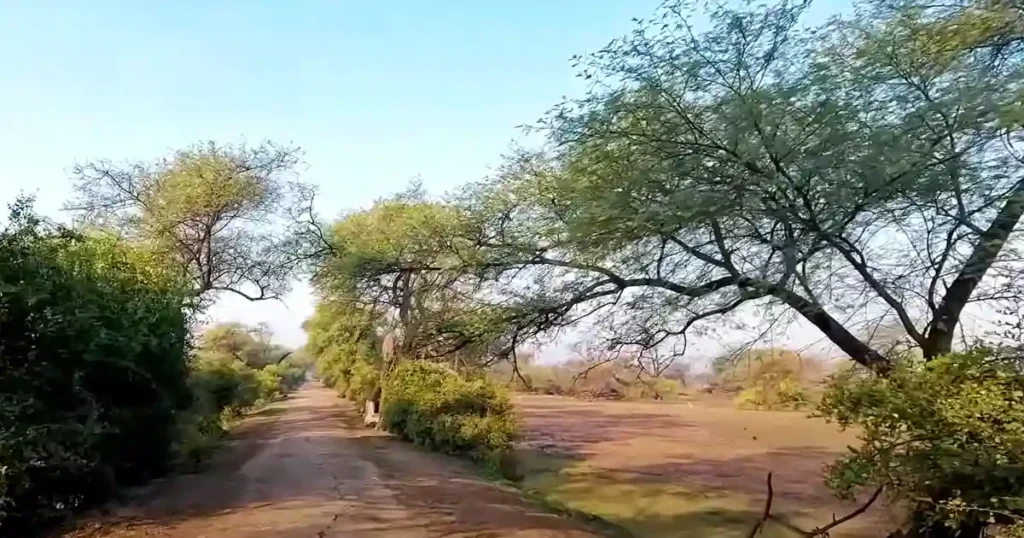
Ajan Bandh: Key Water Source for Keoladeo National Park
Ajan Bandh, located 500 meters southwest of Keoladeo National Park, is the main source of water supply to the park. Water supply to this bandh itself is obtained from the Gambhir and Banganga rivers. Water from Gambhiri reaches Ajan Bandh via the Pichuna Canal, and water from Banganga via the Uchain Canal. However, for the past few years, supplies have been erratic and inadequate.
Ajan Bandh stores the water for a few days and allows the silt to depose, then is discharged through the Ghana Canal to villages and the park. The process helps in settling the particulate organic matter, hence benefiting the crops and reducing siltation in the wetland.
Water is stored in the Ajan Bandh for only about two months, with inflows primarily during July-August and sometimes during August-September. By September, the bandh is drained and the bed is used for growing kharif crops. The timing of water release from the impoundment is very important for the growth of aquatic plants and the breeding of birds and, in general, for the ecology of the park.
Flora and Fauna in Keoladeo National Park
Formerly known as the Bharatpur Bird Sanctuary, the Keoladeo National Park is famous for its assemblages of water birds, both resident and migratory, and is recognized as one of the world’s most important bird breeding and feeding grounds.
Keoladeo National Park is locally called Ghana, a large, shallow, saucer-like depression extending up to 29 sq. km. with a mosaic of grasslands, woodlands, woodland swamps, and wetlands. The park is rich in biodiversity, providing various habitats for 375 species of birds, among which as many as 140 species are waterfowl. It also provides for 372 plant species, 34 mammal species, 57 fish species, 14 snake species, 5 lizard species, 3 gecko species, 7 turtle species, 8 amphibian species, 71 butterfly species, more than 16 dragonfly species, and 8 spider species.
There are over 200 research publications on this park. The decade-long study by the Bombay Natural History Society, apart from various others by institutions, NGOs, and universities, has provided significant insights into the park’s biodiversity.
1.Flora:
One-third of the KNP habitat comprises wetland systems comprising various types of microhabitats, such as trees, mounds, dykes, and open water with or without submerged or emergent plants. The uplands consist of grasslands in the form of savannas of tall grass species, interspersed with scattered trees and shrubs in varying densities.
There are also similar habitats with short grasses like Cynodon dactylon and Dicanthium annulatum. Woodlands with thickets of large Kadam trees (Mitragyna parvifolia) exist in small patches. The variety and diversity of flora are impressive, with a floristic composition totaling 379 species of flowering plants, of which 96 are wetland species.
2.Birds:
Keoladeo National Park served as the only known wintering site for the central population of the critically endangered Siberian Crane. In well-watered years, over 20,000 birds nest at KNP, including a spectacular heronry composed of 15 species of herons, cormorants, spoonbills, ibises, and storks.
Known as a “bird paradise,” the park is a staging ground for migratory waterfowl arriving in the Indian subcontinent along the Central Asian flyway. It hosts 375 avian species, including 140 species of waterfowl. Common migratory ducks in the park include Pintail, Common Teal, Shoveller, Gadwall, Greylag and Bar-headed Geese, Wigeon, and Common Pochard.
Rarely sighted species in the park include Marbled and Baikal Teals, Falcated Teal, Baer’s Pochard, Common Shelduck, Scaup Duck, and White-fronted Goose. There are also 42 species of raptors and 9 owl species.
KNP’s immense biodiversity has qualified it as a World Heritage Site under criteria X, recognizing its significant natural habitats and in-situ conservation of biological diversity, including those with threatened species of outstanding universal value.
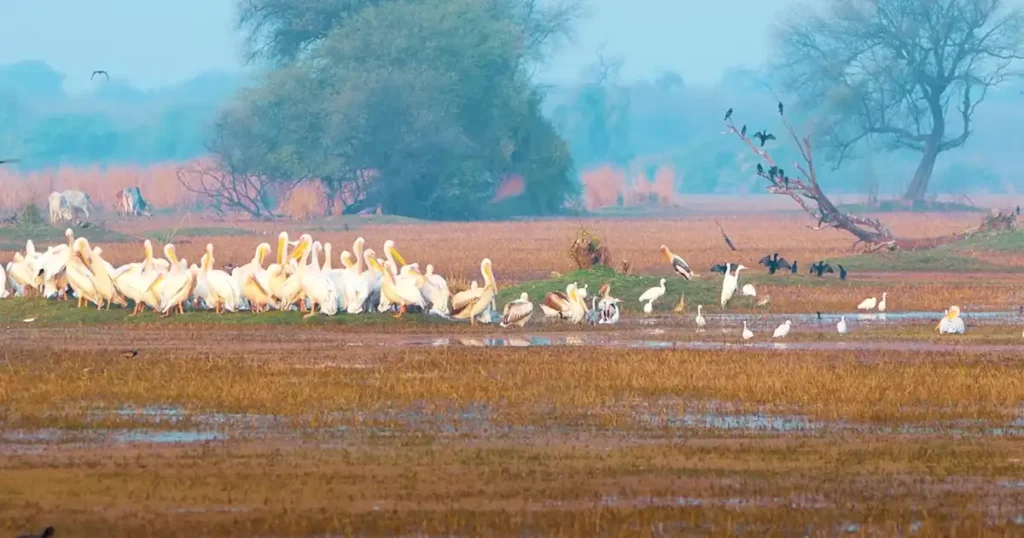
3. Fish:
The wetlands of Keoladeo National Park mainly derive their water inflow from Ajan Bund, which in turn gets its supply from the Banganga and Gambhir rivers. There are 58 species of fishes recorded in Keoladeo Ghana National Park of which 37 enter the park along with the water from Ajan Bund, and 6 species are breeding residents. Of these, 7 species are new and were reported after 1995.
The African catfish is one of the most dangerous invasive aquatic species in the park. During a good rainy season, the park receives a maximum of around 65 million fish fry and fingerlings. The diversity of the fish population is very important as it forms the food source for many birds.
The highest number of fish species recorded in open water with sparse vegetation varied with the lowest recorded from Paspalum-dominated areas of the wetland. The non-air-breathing fishes showed a preference for areas with the least vegetation, while the air-breathers like Channa punctatus, C. striatus, Clarias batrachus, and Heteropneustes fossilis were found in rather widely differing habitats, with Channa punctatus frequently occurring even in thick Paspalum-dominated areas.
There is limited movement within the core areas of heavy vegetation, and decomposition reduces the amount of dissolved oxygen. Thus, non-air-breathers are not found in these habitats. Other physicochemical parameters, like carbon dioxide and methyl orange alkalinity, were also found to be significantly different in the vegetated and non-vegetated waters.
Fish fauna of the park comprises 43 species, of which 37 enter the park along with the water from Ajan Bund, and six species are breeding residents. During the good rainy season, the park receives a maximum of around 65 million fish fry and fingerlings. The fish population and diversity are very important as they form the food source of many birds.
4. Amphibians:
An assessment of the distribution pattern and status of anurans in Keoladeo National Park has reported 6 species of frogs and 2 species of toads. Thus, out of 12 species in Rajasthan, KNP harbors 8 species of anurans. The maximum distribution of the Ornate Narrow-mouthed Frog, Indian Skipping Frog, and Cricket Frog has been observed in the wetlands.
The distribution of the Indian Green Frog is restricted to a few core wetland sites, whereas the Indian Bull Frog has a scattered distribution pattern. The Marbled Balloon Frog is found in the N and L blocks. The 2 toad species are mainly recorded during the night.
The Marbled Toad is present all over the marginal areas of blocks with water, while the Common Asian Toad is mainly recorded in terrestrial habitats and is more prone to man-made sites within the blocks.
5. Reptiles:
In Keoladeo National Park, Indian pythons are active during the day from 0600 to 1800 hrs. They exhibit diurnal behavior in winter, uniformity in spring, and bimodal-crepuscular behavior in summer. The burrow temperatures are like ambient temperatures during the day but warmer at night, while the prey comes out in the mornings and evenings. This decline might be because of summer emigration or reduced basking.
The Indian Flapshell turtle aestivates for about 160 days at depths of 2 to 10 cm, with a mean of 5.2 cm. There is the greatest density near drying water bodies and densities peak within 50 m of the last drying water. Diurnal substratum temperatures range from 28°C to 48°C. Unlike other turtles, the Indian Flapshell remains in its aestivation site until the monsoon, making it the only truly aestivating species in Bharatpur.
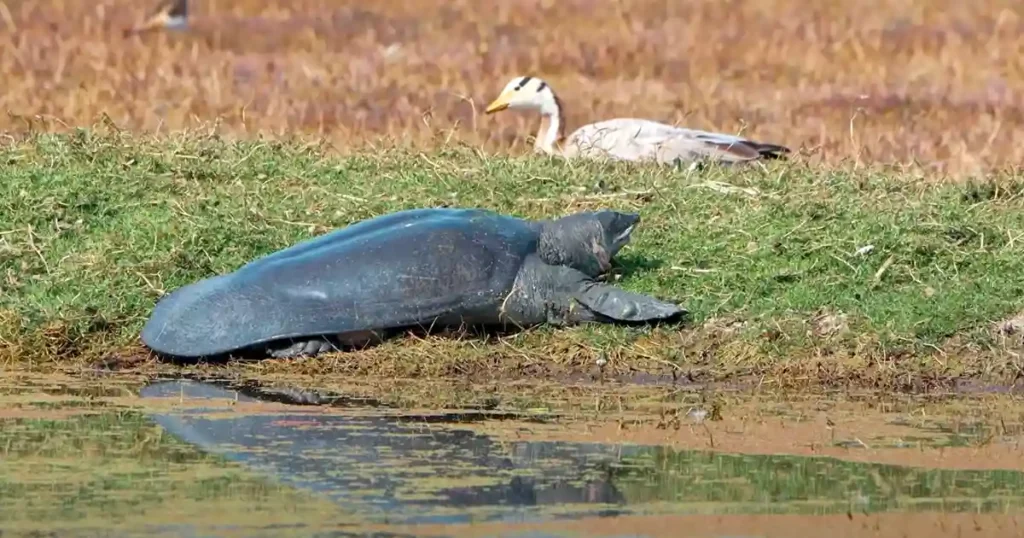
6. Mammals:
Keoladeo Ghana National Park is renowned as one of India’s finest waterbird sanctuaries but also historically harbored big game species like the blackbuck, nilgai, and chital, as well as sambar, hog deer, and leopard during the 1960s. Other mammals recorded include the fishing cat, common palm civet, striped hyena, and common mongoose.
The diet of the smooth Indian otter showed that fish were the primary prey throughout the year, with molluscs in summer, and birds and insects in the monsoon and winter.
A study on the foliage-as-fruit hypothesis found that seeds of Paspalum distichum were present in the dung of nilgai, feral cattle, and wild boar throughout the year, while Acacia nilotica and Prosopis juliflora seeds appeared in the hot-dry season, and Echinochloa crusgalli seeds during the monsoon. A total of 37 small-seeded species germinated from the dung of these animals.
7. Invertebrates:
Though not widely known, larger invertebrate species play a very important ecological role in Keoladeo National Park. More than 100 species of butterflies have been recorded in Bharatpur, out of which about 80 have been seen inside the park in different seasons. More than 30 species of odonate are found in the park. In addition, more than 30 species of spiders and 10 types of beetles have been reported. Notably, one of the chitinous insects controlling the population of the invasive plant Ipomoea reptans is a beetle called Cassida circumdata.
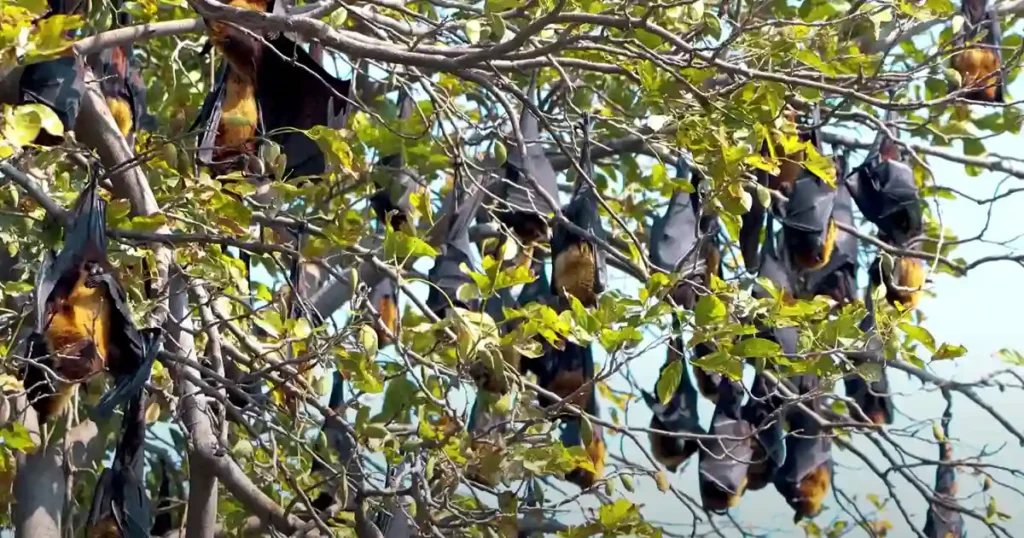
How to Reach Keoladeo National Park
The nearest airport is in Agra, 56 km away from Bharatpur. Delhi is 184 km from Bharatpur, and the city is well-connected by regular train services to major cities like Delhi, Mumbai, Jaipur, and Agra. The Bharatpur railway station is conveniently located just 5 km from the park.
One can reach the park by road using a bus or E-rickshaw from Bharatpur, which is just 2 km away. The park is located along the Jaipur-Agra Road and can be reached in about 5 minutes (2.0 km) via Bijli Ghar Road and NH21, the fastest route despite the usual traffic.
Where to Stay
An RTDC Lodge is available inside the Keoladeo National Park and several local hotels are located just outside the park gate.
Conclusion
Keoladeo National Park, also known as Keoladeo Ghana National Park or Bharatpur Ghana Bird Sanctuary, is a globally renowned bird paradise and one of the best waterfowl reserves in the world, hosting both resident and migratory birds. It spans 28.73 sq. km and features a mosaic of grasslands, woodlands, woodland swamps, and wetlands. The park boasts incredible biodiversity, with 375 bird species, 372 plant species, 34 mammal species, 57 fish species, 14 snake species, 5 lizard species, 7 turtle species, 8 amphibian species, 71 butterfly species, and more than 16 dragonfly species.
With a history as a duck shooting reserve since the 1850s, it is uniquely recognized under both the Ramsar Convention (1971) and as a UNESCO World Heritage Site (1985).
Notably, Keoladeo National Park is one of only three places in the world known to harbor wintering Siberian cranes. The best time to visit the park is from October to March, when migratory birds are present, making it an ideal destination for wildlife enthusiasts and bird watchers. This park’s rich biodiversity and historical significance make it a vital sanctuary for wildlife conservation and a cherished natural heritage.
FAQs
- What is Keoladeo National Park famous for?
A: Keoladeo National Park is famous for its assemblages of water birds, both resident and migratory, and is popularly known as a ‘bird paradise’. It is recognized as one of the world’s most important bird breeding and feeding grounds. - On which river is Keoladeo National Park situated?
A: Keoladeo National Park is situated on the extreme western edge of the Gangetic basin, where the Rivers Gambhir and Banganga, tributaries of the Yamuna, once converged, in the Bharatpur district of Rajasthan, India. - In which district is Keoladeo National Park?
A: Keoladeo National Park is located in the Indian state of Rajasthan in Bharatpur district. The area of Keoladeo National Park is 28.73 sq. km. - Is Keoladeo National Park listed by UNESCO?
A: Keoladeo National Park was listed as a World Heritage Site by UNESCO under the World Heritage Convention in 1985. - The relevance of Keoladeo National Park listed in UPSC examinations.
A: Spread over an area of 28.73 sq. km. Keoladeo National Park is situated at the confluence of the Banganga and Gambhir rivers in the district of Bharatpur, Rajasthan. It was notified as a national park in 1981, notified as the Bharatpur Bird Sanctuary in 1956, declared a Ramsar site in 1971, and listed as a World Heritage Site by UNESCO in 1985.
You May Also Like
- Desert National Park
- Simbalbara National Park
- Pin Valley National Park
- Khirganga National Park
- Inderkilla National Park
References:
- RJ.2539 RAJASTHAN GAZETTE Extraordinary dated the 27th August 1981.
- Ministry of Environment, Forest and Climate Change Notification, New Delhi, the 19th of July, 2019.
- Participatory Management Planning for the Keoladeo National Park, Bharatpur by Biksham Gujja WWF-International.
- The Birds of Bharatpur William C. Selover* 1257 Union Street, San Francisco, CA 94109, U.S.A. Email: WSelover@ix.netcom.com.
- Keoladeo Ghana National Park, Bharatpur: A World Heritage Site by V B Mathur, K Sivakumar, Bhumesh Singh, Anoop K R. WII, July 2009.
- BirdLife in Ghana Bird Sanctuary, Bharatpur (India), Before and After the 1979 Drought by Abraham Verghese, A.K. Chakravarty, and R.K. Bhatnagar.

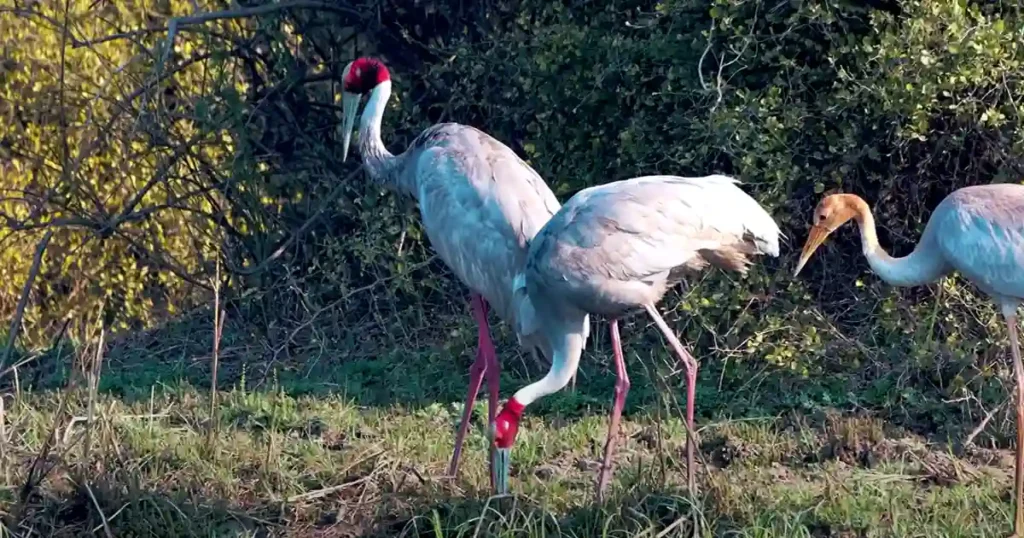

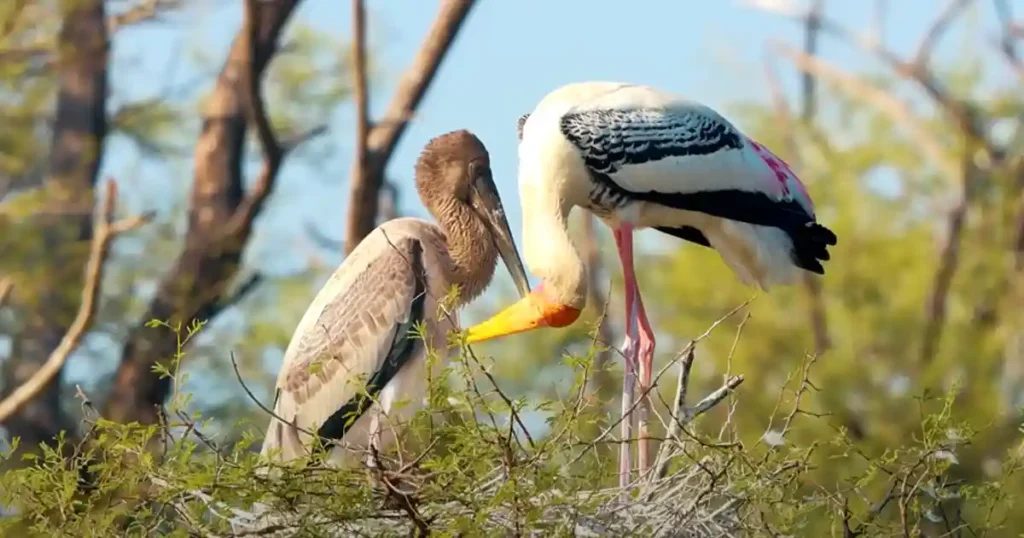

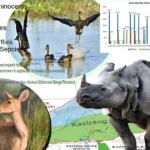
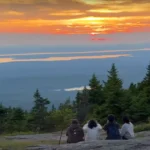
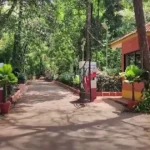
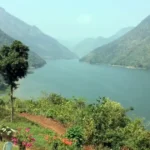


2 thoughts on “Keoladeo National Park”